|
||
      |
Features ::
Eight Gables
Defined as “the outside section of a wall within the triangular space formed by the sloping eaves of a roof,” a gable sounds, well, humdrum. But as photographer Dan Dry has discovered, the interiors of Chicago’s gabled halls hold some surprises.
Say gable and most people think Clark. The English majors in the crowd remember Nathaniel Hawthorne and his romance named for a down-at-the-heels house in Salem, Massachusetts, whose seven gables were its architectural distinction. A common feature of late English Gothic—the style that the University’s first architect, Henry Ives Cobb, somewhat reluctantly chose for the Quadrangles, pressured by the Board of Trustees—gables give the campus skyline a comforting, picket-fence regularity. Whether crowned with finials, decorated with crockets, or punctuated with windows both ornamental and utile, from the outside every gable on campus remains defined by its triangular shape. On the inside, however, it’s a different story.
Click on each image for a full-view.
 FACULTY
OFFICE, SWIFT HALL
FACULTY
OFFICE, SWIFT HALL
Since giving up her Rockefeller digs in 1997 because of a space crunch,
Alison Boden, dean of Rockefeller Memorial Chapel and a senior lecturer
in the Divinity School, has called Swift 406A home. The plastic flowers
that dominate her dormer alcove “were in front of the altar in Bond
Chapel about five years ago,” she says, “when I presided at
a brief eucharist for a gay couple on their anniversary. They invited me
to keep the flower arrangement,” and each year she takes it back to
Bond for the next celebration.
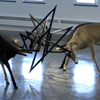 RENAISSANCE
SOCIETY GALLERY, COBB HALL
RENAISSANCE
SOCIETY GALLERY, COBB HALL
“The Renaissance Society’s harshly angled, highly vaulted architecture
functions as the stage for exposing the latent Gothic impulse in contemporary
America,” Hamza Walker, AB’88, writes in the catalog for the
fall exhibit All the Pretty Corpses. Case in point: John Espinosa’s
150%. The 2003 installation—of polyurethane foam, white-tail
deer capes, bondo, wood, acrylic, and rhinestones—gains depth from
angles and shadows, both amplified by Cobb Hall’s gabled roof.
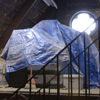 THERMAL
SYSTEMS STORAGE ROOM, HASKELL HALL
THERMAL
SYSTEMS STORAGE ROOM, HASKELL HALL
Opened as the Haskell Oriental Museum in 1896, Haskell Hall housed the University’s
collection of Near East artifacts, the Department of Semitic Languages and
Literatures, and the offices of Chicago’s first president, William
Rainey Harper. With the Oriental Institute opened in 1932, Haskell Hall
was remodeled for the Graduate School of Business. In 1979 it was retrofitted
again, for the Department of Anthropology. The attic’s A-frame offers
plentiful storage space.
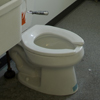 BATHROOM,
MIDWAY STUDIOS
BATHROOM,
MIDWAY STUDIOS
Home of the Department of Visual Arts’ graduate and undergraduate
studios, sculptor Lorado Taft’s landmark Midway Studios, a cluster
of studios and artists’ homes, grew, as Taft once wrote, “like
the chambered nautilus, cell by cell.” The homey, hodge-podge feeling
remains, with work spaces and ad hoc galleries found up one stair and down
another. A third-floor unisex lavatory pays homage to sculpture (witness
the toilet tank) and still life (windowsill as impromptu installation space).
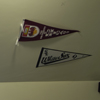 SINGLE,
BURTON-JUDSON COURTS
SINGLE,
BURTON-JUDSON COURTS
When it comes to slanted-wall decor, undergrad Ryan Naughton keeps it simple:
pennants for two of the home teams. As Naughton, a second-year from Virginia
Beach, Virginia, told the Chicago Maroon during the World Series
race, “I do not yet consider myself a true Chicagoan or Sox fan in
the extreme sense that some people claim to have been a Sox fan while in
the womb and that there is no substitute. Does this forever destine me to
truly be only a second-rate fan? I don’t think so.”
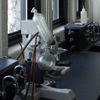 ORGANIC
LAB, KENT CHEMICAL LABORATORY
ORGANIC
LAB, KENT CHEMICAL LABORATORY
On the last day of fall quarter, Kent’s organic chemistry lab takes
on a monastic air, echoing the Gothic exterior of the University’s
first chemistry building. Inside, most Gothic details have vanished from
the labs, renovated most recently in 1985. Each Tuesday through Friday afternoon
all autumn, the room buzzed with beginning and intermediate organic-chemistry
students. Now lab benches stand empty and bright-yellow lab aprons hang
neatly on the room’s western wall, waiting for winter quarter to begin.
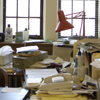 ASSYRIAN
DICTIONARY OFFICE, ORIENTAL INSTITUTE
ASSYRIAN
DICTIONARY OFFICE, ORIENTAL INSTITUTE
The Chicago Assyrian Dictionary began in 1921, more than a decade before
the Oriental Institute opened its doors. This summer the letter P—No.
23 in the 26-volume effort to document every word of the Akkadian language—made
its appearance. Two other volumes are in press, with the final volume due
in 2006. But, as evidenced by Manuscript Editor Linda McLarnan’s (AM’82)
desk, work is not yet done. Scholars review the volumes for three years
before they are published in final form.
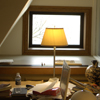 FACULTY
OFFICE, WALKER MUSEUM
FACULTY
OFFICE, WALKER MUSEUM
This year the Division of the Humanities became the main tenant of the Walker
Museum (built as the Walker Oriental Museum and precursor to the Oriental
Institute). Along with administrative offices and meeting spaces on the
second floor, the building houses the division’s two largest departments,
English Language & Literature and Philosophy. On the fifth floor, associate
professor of English Lisa Ruddick gets half of a Walker gable—a colleague
next door gets the rest.